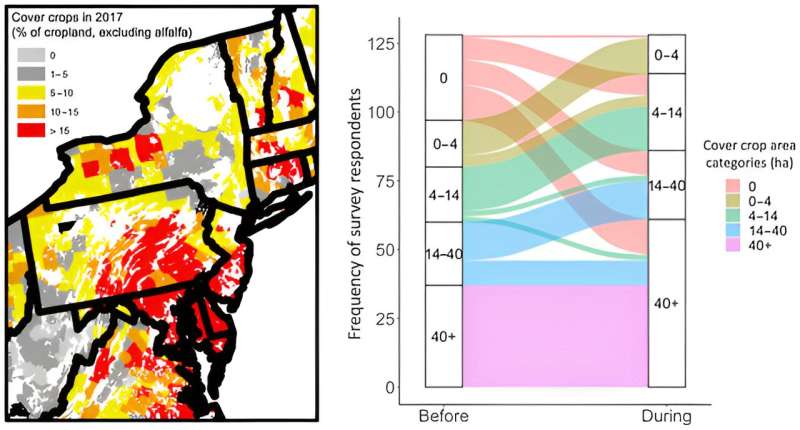This article has been reviewed according to Science X's editorial process and policies. Editors have highlighted the following attributes while ensuring the content's credibility:
fact-checked
trusted source
proofread
Incentive programs doubled cover crop use by farmers: Study

A survey of farmers in four Northeast states, including New York, found that incentive payments encouraged participants to plant twice as many acres of cover crops as they did prior to receiving funds—a change that can both improve their farms and mitigate climate change.
These incentive programs also had a lasting effect, with many farmers continuing the practice even after payments ceased.
Cover crops are crops that are planted for their on-farm benefits such as reducing soil erosion, improving soil health, pest control, nutrient cycling and nitrogen fixation, while also providing off-farm benefits of protecting surface water quality and mitigating climate change.
"Cover crops are one of the best tools we have for improving soil health, and helping farmers be more resilient to extreme weather events," said Matthew Ryan, associate professor of soil and crop sciences in the College of Agriculture and Life Sciences.
Ryan is senior author of a paper, "Incentive Programs Promote Cover Crop Adoption in the Northern United States," published in the journal Agricultural and Environmental Letters. Barbara Chami, M.S. '18, a project manager at the San Francisco Recreation and Parks Department, is the paper's first author.
Cover crops don't provide farmers with immediate returns on their investments, unlike cash crops, which they can sell at the end of a season, Ryan said. "It's really important to be able to provide funding to help farmers explore the use of cover crops, and get started and integrate them into their operations," he said.
In the study, 328 farmers in New York, Pennsylvania, Maryland and Vermont were surveyed. The online survey sought to understand what types of people participated in incentive programs and to assess the effect of incentive programs on cover crop adoption.
The results revealed that on average, farmers who engaged in incentive programs doubled the amount of land devoted to cover crops, from close to 51 hectares (125 acres) prior to engaging in an incentive program to 101 hectares (250 acres) after they started. Also, after payments ceased, cover crop use remained on average 37% greater than before a farmer enrolled in a program. "So there's a lasting legacy effect," Ryan said.
The survey found that participants were typically more experienced, male farmers with larger conventional farms.
"One thing we were thinking, if we want to reach a broader audience with these programs, we should target farmers who are different from those who have already participated," Ryan said. These may include new and beginning farmers, women farmers, those operating smaller farms and organic farmers, Ryan said.
The U.S. Department of Agriculture (USDA) National Resources Conservation Service offers cover crop incentive programs in all states. New York also offers multiple programs through the New York State Department of Agriculture and Markets.
Most of the programs, aside from one offered in Maryland, are not indefinite, with payments ceasing, highlighting the need to understand longer-term effects after engaging in a program.
The Inflation Reduction Act and new climate-smart commodity funding will make additional funding available for cover crop incentive programs through the USDA, Ryan said.
Co-authors include Stephen Parry of the Cornell Statistical Consulting Unit, and researchers from the University of Vermont, the University of Maryland and the USDA Agriculture Research Service in Beltsville, Maryland.
More information: Barbara Chami et al, Incentive programs promote cover crop adoption in the northeastern United States, Agricultural & Environmental Letters (2023). DOI: 10.1002/ael2.20114
Provided by Cornell University


















